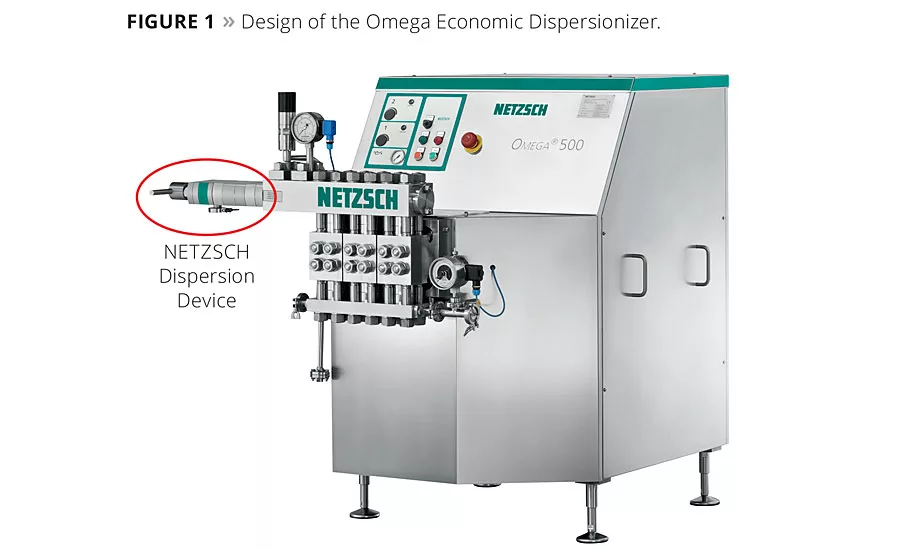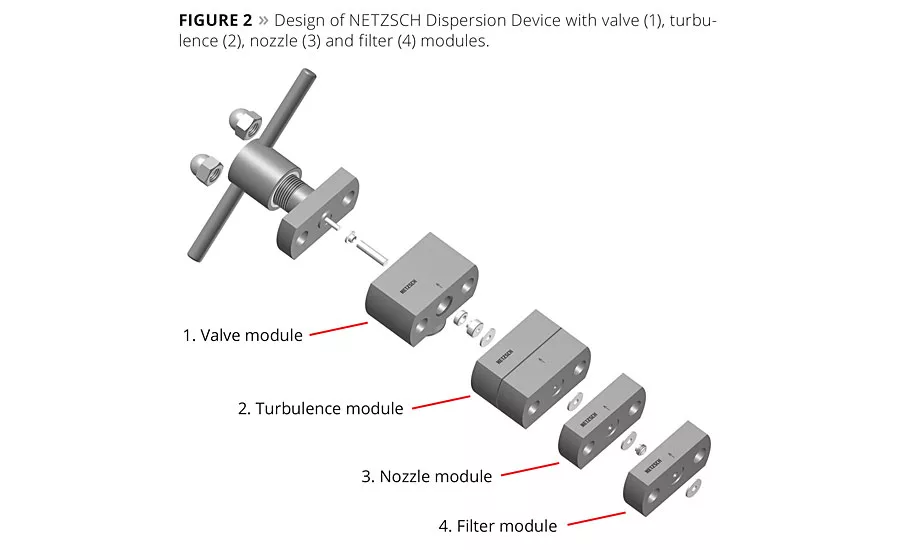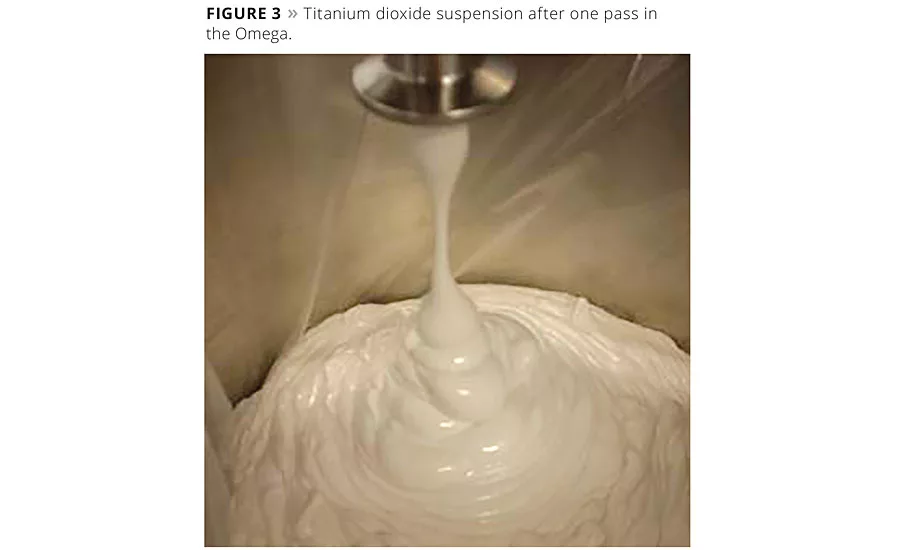Dispersing Without Grinding Media




A crushing or dispersing process is required in the manufacture of many different products. For some applications with the goal of achieving deagglomeration, disaggregation or delamination, manufacturing technologies are often applied for which optimization is both desired and necessary. With new Omega® technology from NETZSCH-Feinmahltechnik GmbH, optimization is often possible for such applications in terms of power requirements, output and service life of the machine, as well as ease of cleaning and operation. The function of this machine is similar to that of a high-pressure homogenizer. Due to the unique modular construction of the dispersing unit, the essential difference is that the Omega operates with a maximum pressure of only 700 bar. Thus, compared to agitator bead mills or high-pressure homogenizers, a savings in specific energy of more than 50% can be achieved for some applications.
True Comminution and Dispersing
The various methods of producing ultrafine particles by crushing coarse particles are referred to as dispersion methods or “top-down” processes. For such a crushing task, high energy densities such as those realized in agitator bead mills, for example, are available. These are used in many branches of industry for the crushing of raw materials as well as the dispersion of ultrafine pigments and products from “bottom-up” processes. In contrast to the bottom-up processes, wet grinding in agitator bead mills creates particles that deviate from a spherical shape. The product is in the form of primary particles stabilized in a suspension and, for many applications, can undergo further processing directly, without additional preparation.
While during true comminution of coarse primary particles, the individual primary particles must be subjected to compressive and impact stresses in order to trigger fractures, these direct stresses often damage agglomerated nanoscale primary particles during dispersion. This is due to the change in the mechanical properties of the product particles from brittle-elastic to plastic with decreasing size. Material structure transitions from crystalline to amorphous, or mechano-chemically triggered reactions, can have a negative effect on the product properties. Agglomerates of nanoscale primary particles should, therefore, be stressed primarily through shearing.
On one hand, this can be realized through the use of extremely small grinding media at very low peripheral speeds in an agitator bead mill. On the other hand, in most cases, turbulent shear flows combined with high differences in speed and cavitation stresses lead to more energy-efficient dispersion processes. This is the basis for the Omega Economic Dispersionizer. Through the optimal utilization of turbulence, cavitation and shearing forces, this machine guarantees the greatest possible reproducible product quality with considerably reduced energy expenditure and maintenance, and minimal heat generation during dispersion.
Operating Principle
The operating principle of the Omega is similar to that of commercially available high-pressure homogenizers, which can be run at pressures up to 3,000 bar. Major differences relate to the modular construction of the Omega dispersing unit. The product dispersion is pumped at a constant flow rate through the NETZSCH Dispersion Device (Figures 1 and 2) by means of the medium-pressure piston pump. In the process, the filter module retains contamination such as fibers, hair or coarse particles in order to prevent clogging or damage to the nozzle module. In the nozzle module, the dispersion is accelerated to speeds up to approximately 350 m/s, which is why the first shear and elongation stresses appear here. The latter can be understood as an expansion of the material in the dispersed phase due to the high accelerating force and is relevant primarily for emulsification. In the turbulence module, the product dispersion experiences combined stress, caused by the turbulent shear flow and the cavitation after exiting the nozzle. In the production of emulsions, the deformation in laminar elongational flow into and upon exit from the nozzle is responsible to a great extent for atomization of the droplets of the dispersed phase. For applications in the coatings industry, this laminar elongational flow provides for effective incorporation of additives into the formulation. The pressure drop across the nozzle, and thus the level of active forces, can be regulated via the nozzle diameter and the flow rate.
In a second pressure stage, the homogenization gap in the valve module can be adjusted by means of spring resistance after the turbulence module. Thus, pressure can be built up again independent of the pressure drop across the nozzle. This pressure is converted to kinetic energy in the homogenization gap, whereby the combined stress of turbulent flow, shear and impact forces act in this component. With the independent control of the pressure drop in the nozzle and valve, the effective forces can be optimized for each product and application through selection of the operating parameters.
Advantages
The combination of shear flow, turbulence, cavitation and impact stress is critical for efficient dispersion. Compared to commercially available high-pressure homogenizers, analogous or somewhat better dispersion results can be achieved at a maximum pressure of 700 bar due to the unique modular construction of the dispersion device.
The considerably reduced pressure drop across the dispersing unit leads to an energy savings that can sometimes exceed 50%. An additional energy savings results from the lower cooling capacity required, since the reduced pressure drop leads to the generation of considerably less heat in the product. The flow control in the dispersion device results in only minor wear on the nozzle and valve modules.
The construction and short holdup of the dispersion device facilitate easy cleaning and quick product changes without cross-contamination. An exchange of individual modules, disassembly or assembly for cleaning or maintenance requires only a few minutes, as the individual modules are mounted on two bolts and secured with two nuts (Figure 2). Likewise, individual modules can be removed if necessary, e.g., the filter module when processing fibers or pelletized carbon black.
Application Areas
Grinding media is not required for dispersion with the Omega unit. Therefore, the technology is not suitable for true comminution or for difficult disaggregation of particles that are partially connected to one another by solids bridges. In contrast to agitator bead mills, grinding progress and hence required color values cannot be achieved here through the selection of suitable operating parameters. The application range of the machine lies in the area of deagglomeration and light disaggregation tasks, but also the delamination of flaky particles, the defibration (defibrillation) or unbundling of natural fibers or carbon nanotubes, as well as emulsification.
Prior suspension of the solids or emulsification of the liquids is required in every case for application of the Omega technology. Ideally, the dispersed substances are distributed homogeneously in the dispersion medium and perfectly wetted with no air bubbles. The optimal machine for the suspension stage of the process is our Y-MIX® Inline Mixing System.
Application Example: Titanium Dioxide
Conceivable applications are products that are easy to disperse, for which the Omega would constitute an optimization of the existing production system. One such application is the dispersion of titanium dioxide (Figure 3). In a specific case, the required target fineness is achieved by the Omega in one passage. Here, after measurements based on static laser light scattering, the particle size is reduced from 50 µm to a maximum size of 10 µm. In addition to efficient dispersion, highly viscous suspensions can also be processed, thereby achieving high solids contents.
Further, it is conceivable that the Omega could be used in a process with products that are difficult to disperse, for which the first step of comminution is predispersion in an agitator bead mill. This would allow the use of smaller grinding beads in the mill, which would increase both the efficiency of the mill and the entire value-added chain.
Conclusion
With a machine technology that covers a very broad viscosity range, the Omega Economic Dispersionizer often represents an advancement over conventional manufacturing technologies with respect to energy requirements and output as well as ease of cleaning and operation.
The unit is available for tests at NETZSCH locations in Germany, the United States, Brazil and Korea. Feasibility tests can be carried out on both the laboratory and pilot plant scale in the applications laboratories. In addition, comprehensive, modern analysis is available for determination of the success of the dispersion process and the change in the product viscosity.
For more information, visit www.netzsch.com.
This article originally appeared in the European Coatings Journal.
By Sven Hoffmann, Technical Support; and Michael Schmidt, Managing Director NETZSCH Vakumix | NETZSCH-Feinmahltechnik GmbH, Selb, Germany
Looking for a reprint of this article?
From high-res PDFs to custom plaques, order your copy today!




